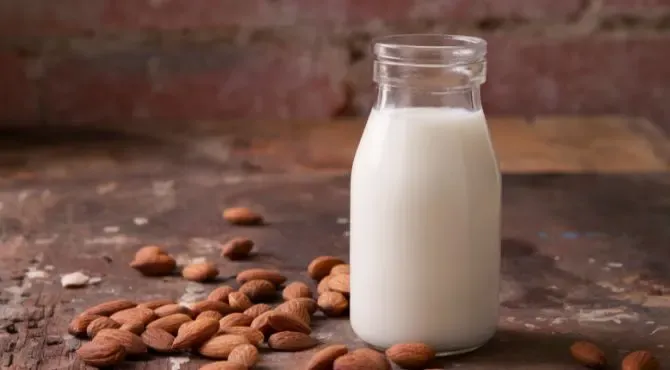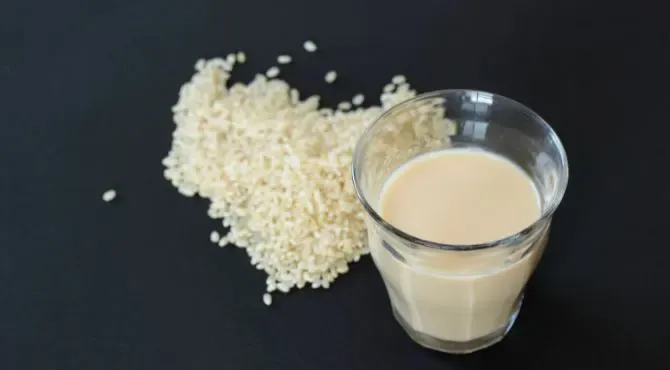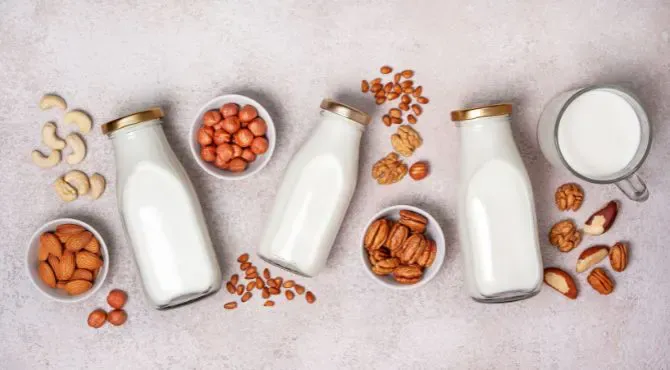How to choose the suitable vegetable milk?

But also by those who wish to reduce their environmental impact.
Vegetable milk is made from cereals (rice), legumes (soy) or oilseeds (almond). There is a wide range of them today; there is even hemp and quinoa milk.
Depending on the recipe, additional ingredients may be added, such as sunflower oil, sugar, or calcium. You can also make them yourself.
Precaution: ANSES reminds us that plant-based drinks are unsuitable for infants under one year and do not have the same nutritional qualities as animal milk. To avoid the risk of confusion, the European Commission does not authorize the trade name "milk" for these drinks except those made from almonds or coconut.

Manufacturing: Soy milk is undoubtedly the best-known vegetable milk!
The soybeans are soaked, and then their skin is removed. Then we grind them,
add water and cook them. Finally, the mixture obtained is filtered.
Nutritional contributions: The protein content of soy milk is similar to that of cow's milk, and these are vegetable proteins that contain all the so-called essential amino acids. Its fat content is lower. However, there are certain contraindications to its consumption (see the second part).
Recipe ideas: soy milk has a slightly bitter nutty taste, and it foams quite easily and can use in a café latte. It can use in recipes for waffles and pancakes. But also to make flans and desserts. Salty side in a vegetable gratin or an asparagus velouté.

Manufacturing: Almond milk is made from almonds soaked in water to rehydrate and mixed with water, and the preparation thus obtained is filtered. Commercial almond milk is often fortified with sugars or calcium and other additives.
Nutritional benefits: Plain almond milk is low in calories and contains low carbohydrates, and its glycemic index is low. It contains vitamin E, an antioxidant that limits cellular and tissue ageing, and it is also a source of magnesium.
Recipe ideas: almond milk has a sweet and light flavour, and it can use in a recipe for cherry or apricot clafoutis. In cappuccino or hot chocolate instead of milk. In a carrot velouté or a sauce to accompany cod.

Manufacturing: Rice milk is made from the grains of the rice cereal,
and the grains are ground into semolina which is stirred with water, and the
mixture is then heated and filtered. In Japan, there is a fermented rice
drink called amazake.
Nutritional contributions: Rice milk is an alternative to cow's milk, low in fat and one of the most digestible. It is vegetable milk rich in carbohydrates; its glycemic index is high. Rice drinks have a fairly low protein intake.
Recipe ideas: its taste is neutral. It can use in a rice pudding recipe! In cake recipes such as madeleines. In a lemongrass and spice sauce to accompany salmon. In a recipe for a cake with vegetables from the sun, pepper, zucchini etc.

Manufacturing: This milk is produced from oats, one of the first cereals
domesticated by man. The first step in making it is to soak the grains in
water, and then we mix them and filter the preparation.
Nutritional benefits: Oat milk is about as caloric as cow's milk, and it contains soluble fibre, including beta-glucans acting on bad cholesterol, as highlighted in this study. These fibres also increase the feeling of satiety.
Recipe ideas: oat milk has a slightly sweet and mild flavour, and it can use in porridge and pancakes and savoury preparations such as sauces or vegetable purees or a pumpkin soup. Try our oat milk matcha latte recipe!

First of all, from a nutritional point of view, plant-based milk is not recommended for certain audiences. For example :
Rice milk has a high GI; diabetics are recommended to limit their consumption.
Soy milk contains substances called isoflavones. It is not recommended for people who have a personal or family history of hormone-dependent cancers.
Depending on the recipes you are going to make, adapt your choice. For
example, almond milk goes well with summer fruits like cherries and
apricots.
The composition of vegetable drinks is checked by scrutinizing the labels.
Some are enriched with calcium from seaweed or vitamins, which can be interesting depending on their assimilability. But other drinks have longer lists of additives (sugars, stabilizers).
To master the composition of your vegetable drink, why not learn about homemade preparations?
To sum up :
Vegetable milk is made from cereals (rice), legumes (soy) or oilseeds (almond). There is a wide range of them today; there is even hemp and quinoa milk.
Depending on the recipe, additional ingredients may be added, such as sunflower oil, sugar, or calcium. You can also make them yourself.
Which is the best vegetable milk?
Here are four vegetable milk, their production methods and their benefits after the list, and our advice for choosing the vegetable milk that best suits your needs.Precaution: ANSES reminds us that plant-based drinks are unsuitable for infants under one year and do not have the same nutritional qualities as animal milk. To avoid the risk of confusion, the European Commission does not authorize the trade name "milk" for these drinks except those made from almonds or coconut.
Soy milk

Nutritional contributions: The protein content of soy milk is similar to that of cow's milk, and these are vegetable proteins that contain all the so-called essential amino acids. Its fat content is lower. However, there are certain contraindications to its consumption (see the second part).
Recipe ideas: soy milk has a slightly bitter nutty taste, and it foams quite easily and can use in a café latte. It can use in recipes for waffles and pancakes. But also to make flans and desserts. Salty side in a vegetable gratin or an asparagus velouté.
Almond milk

Manufacturing: Almond milk is made from almonds soaked in water to rehydrate and mixed with water, and the preparation thus obtained is filtered. Commercial almond milk is often fortified with sugars or calcium and other additives.
Nutritional benefits: Plain almond milk is low in calories and contains low carbohydrates, and its glycemic index is low. It contains vitamin E, an antioxidant that limits cellular and tissue ageing, and it is also a source of magnesium.
Recipe ideas: almond milk has a sweet and light flavour, and it can use in a recipe for cherry or apricot clafoutis. In cappuccino or hot chocolate instead of milk. In a carrot velouté or a sauce to accompany cod.
Rice milk

Nutritional contributions: Rice milk is an alternative to cow's milk, low in fat and one of the most digestible. It is vegetable milk rich in carbohydrates; its glycemic index is high. Rice drinks have a fairly low protein intake.
Recipe ideas: its taste is neutral. It can use in a rice pudding recipe! In cake recipes such as madeleines. In a lemongrass and spice sauce to accompany salmon. In a recipe for a cake with vegetables from the sun, pepper, zucchini etc.
Oat milk

Nutritional benefits: Oat milk is about as caloric as cow's milk, and it contains soluble fibre, including beta-glucans acting on bad cholesterol, as highlighted in this study. These fibres also increase the feeling of satiety.
Recipe ideas: oat milk has a slightly sweet and mild flavour, and it can use in porridge and pancakes and savoury preparations such as sauces or vegetable purees or a pumpkin soup. Try our oat milk matcha latte recipe!
How to choose your vegetable milk?

Composition and taste of vegetable milk
Different criteria must be taken into consideration when choosing plant-based drinks.First of all, from a nutritional point of view, plant-based milk is not recommended for certain audiences. For example :
Rice milk has a high GI; diabetics are recommended to limit their consumption.
Soy milk contains substances called isoflavones. It is not recommended for people who have a personal or family history of hormone-dependent cancers.
Then the taste. Soy milk and oat milk have stronger flavours than almond and rice milk.
The composition of vegetable drinks is checked by scrutinizing the labels.
Some are enriched with calcium from seaweed or vitamins, which can be interesting depending on their assimilability. But other drinks have longer lists of additives (sugars, stabilizers).
To master the composition of your vegetable drink, why not learn about homemade preparations?
To sum up :
| Soy milk | Almond milk | rice milk | oat milk | |
|---|---|---|---|---|
| Nutritional intakes | Complete plant protein Low fat | Vitamin E and magnesium Low glycemic index | Low in digestible fat | Soluble fibre |
| Disadvantages | Not recommended: pregnant and breastfeeding women, history of hormone-dependent cancers | Not recommended in case of allergy to nuts. Low protein intake | High glycemic index Low protein intake | Not recommended: gluten intolerant or people with celiac disease Low protein intake |
| Taste / recipe ideas | Hazelnut taste, bitterness Café latte, waffles, pancakes, vegetable gratin, asparagus velouté | Almond taste, sweetness Clafoutis with summer fruits, cappuccino, hot chocolate, carrot velouté, sauce to accompany fish | Taste of rice, lightness Rice pudding, cakes, madeleines, lemongrass and spice sauce to accompany fish, sunny vegetable cake | Strong taste, sweetness Porridges, pancakes, matcha latte, sauces, vegetable purees, pumpkin soup |
Vegetable milk, good for everyone
Today, one out of four French people drinks vegetable milk (soy,
almond, rice, oats, hazelnut, etc.). A supermarket that offered ten
vegetable milk references two years ago now offers around sixty!
The market grew by 10% between 2019 and 2020 (which corresponds to 78 million bottles), even if it is twice as expensive as cow's milk. Its ecological impact is much lower than cow's milk, especially from locally grown plants such as French soybeans.
The market grew by 10% between 2019 and 2020 (which corresponds to 78 million bottles), even if it is twice as expensive as cow's milk. Its ecological impact is much lower than cow's milk, especially from locally grown plants such as French soybeans.
Post a Comment